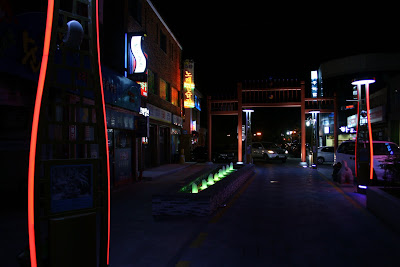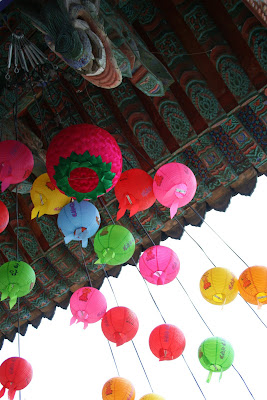I considered taking a ferry, but there are quick, cheap direct flights twice daily from Shizuoka to Seoul (and we all know poor weather can make the most scenic ferry ride vomtastic). Since Seoul is a popular travel destination for many foreigners here in Japan, I’d got a heads-up on the Pizza Hut located at Seoul Station. Since I hadn’t actually eaten at Pizza Hut in ages, I can’t say I was feeling deprived in any way…it’s just, there was something about it being uber-American and available that beckoned me in for a personal-pan cheese and giant Mountain Dew. Don’t scoff at me, Internet; I ate Korean food the rest of my trip.
I picked up my dirt-cheap 3-day all-you-can-ride rail pass and hopped a train to Gyeongju, a city in the southeastern corner of the peninsula that was capital of the ancient Silla Kingdom; I read that Gyeongju is to Korea what Kyoto is to Japan. All aboard.


 I wandered through the quiet town to find Sa Rang Chae, a traditional Korean house divided into guest rooms. This was mine:
I wandered through the quiet town to find Sa Rang Chae, a traditional Korean house divided into guest rooms. This was mine:

 Despite the dreariness, I took a bus southwest of town to Gyeongju National Park, where I visited Bulguk-sa and Seokguram in the forested hills. Bulguk-sa is a temple complex on the side of Toham-san mountain. A temple was first constructed here in 550; the complex grew to include 80 buildings, but after feuds in the 1500’s and the Korean War, only about 8 reconstructed buildings stand today. Nevertheless, Bulguk-sa is the most visited temple in Korea and the brightly-detailed wooden structures are really something to see.
Despite the dreariness, I took a bus southwest of town to Gyeongju National Park, where I visited Bulguk-sa and Seokguram in the forested hills. Bulguk-sa is a temple complex on the side of Toham-san mountain. A temple was first constructed here in 550; the complex grew to include 80 buildings, but after feuds in the 1500’s and the Korean War, only about 8 reconstructed buildings stand today. Nevertheless, Bulguk-sa is the most visited temple in Korea and the brightly-detailed wooden structures are really something to see.

 Buddha's birthday was a few days before my visit, so I'm not sure if the lanterns were displayed for the holiday, or if they're always up.
Buddha's birthday was a few days before my visit, so I'm not sure if the lanterns were displayed for the holiday, or if they're always up.





 The drizzle had become a downpour by the time I reached the exit gate, so I ducked into a tiny shop for bibimbap (hotpot of rice and vegetables with egg scrambled in), spicy tofu soup, and the requisite assortment of kimchi/pickles.
The drizzle had become a downpour by the time I reached the exit gate, so I ducked into a tiny shop for bibimbap (hotpot of rice and vegetables with egg scrambled in), spicy tofu soup, and the requisite assortment of kimchi/pickles. Seokguram, or "Stone Cave Hermitage," is a grotto carved out of the side of the mountain, an hour's hike above Bulguk-sa.
Seokguram, or "Stone Cave Hermitage," is a grotto carved out of the side of the mountain, an hour's hike above Bulguk-sa.

 Along with a few other tourists, I sloshed along the winding, lantern-lined trail for a look at the carved-out cave housing the pale stone Buddha, currently protected by glass inside this wooden building:
Along with a few other tourists, I sloshed along the winding, lantern-lined trail for a look at the carved-out cave housing the pale stone Buddha, currently protected by glass inside this wooden building:
 Back in town, the sun made a brief appearance, so with a change of shoes and socks, I visited Cheomseongdae, which is possibly the oldest astronomical observatory in Asia! While it just looks like a giant stone bottle, this 9-meter tower was built around 640 using specific calculations based on star positions.
Back in town, the sun made a brief appearance, so with a change of shoes and socks, I visited Cheomseongdae, which is possibly the oldest astronomical observatory in Asia! While it just looks like a giant stone bottle, this 9-meter tower was built around 640 using specific calculations based on star positions.




 In the late afternoon, I wandered around 20-some Silla Dynasty burial mounds in Tumulus Park. The park also houses a museum which displays a cross-section of a mound: the coffin is placed on the ground, a small wooden structure is built over it, then the structure is piled with rocks, the tallest mound in the park reaching 23 meters high.
In the late afternoon, I wandered around 20-some Silla Dynasty burial mounds in Tumulus Park. The park also houses a museum which displays a cross-section of a mound: the coffin is placed on the ground, a small wooden structure is built over it, then the structure is piled with rocks, the tallest mound in the park reaching 23 meters high.


 After hanging out in the guesthouse's common area post-dinnertime with a couple German guys and a family from France, the next morning I was off to Busan, Korea's principal port!
After hanging out in the guesthouse's common area post-dinnertime with a couple German guys and a family from France, the next morning I was off to Busan, Korea's principal port! 
No comments:
Post a Comment